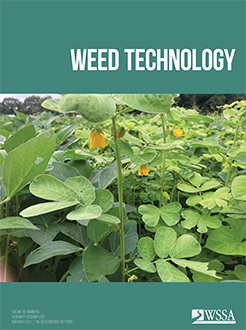Late-season control of Palmer amaranth in postharvest wheat stubble is important for reducing the seedbank. Our objectives were to evaluate the efficacy of late-season postemergence herbicides for Palmer amaranth control, shoot dry biomass, and seed production in postharvest wheat stubble. Field experiments were conducted at Kansas State University Agricultural Research Center near Hays, KS, during 2019 and 2020 growing seasons. The study site had a natural seedbank of Palmer amaranth. Herbicide treatments were applied 3 wk after wheat harvest when Palmer amaranth plants had reached the inflorescence initiation stage. Palmer amaranth was controlled by 96% to 98% 8 wk after treatment and shoot biomass as well as seed production was prevented when paraquat was applied alone or when mixed with atrazine, metribuzin, flumioxazin, 2,4-D, sulfentrazone, pyroxasulfone + sulfentrazone, or flumioxazin + metribuzin, and with glyphosate + dicamba, glyphosate + 2,4-D, saflufenacil + 2,4-D, glufosinate + dicamba + glyphosate, and glufosinate + 2,4-D + glyphosate. Palmer amaranth was controlled by 89% to 93% with application of glyphosate, glufosinate, dicamba + 2,4-D, saflufenacil + atrazine, and saflufenacil + metribuzin resulting in Palmer amaranth shoot biomass of 15 to 56 g m-2 and production of 1,080 to 7,040 seeds m-2. Palmer amaranth control was less than 86% with application of dicamba, 2,4-D, dicamba + atrazine, and saflufenacil resulting in Palmer amaranth shoot biomass of 38 to 47 g m-2 and production of 3,110 to 6,190 seeds m-2. Palmer amaranth was controlled 63% and 72%, shoot biomass was 178 and 161 g m-2, and seed production was 35,180 and 39,510 seeds m-2, respectively, with application of 2,4-D + bromoxynil + fluroxypyr, and bromoxynil + pyrasulfotole + atrazine. Growers should use these effective postemergence herbicide mixes for Palmer amaranth control to prevent seed prevention postharvest in wheat stubble.
Nomenclature: Atrazine; bromoxynil; dicamba; flumioxazin; fluroxypyr; glufosinate; glyphosate; metribuzin; paraquat; pyrasulfotole; pyroxasulfone; saflufenacil; sulfentrazone; 2; 4-D; wheat; Triticum aestivum L.; Palmer amaranth; Amaranthus palmeri S. Watson






